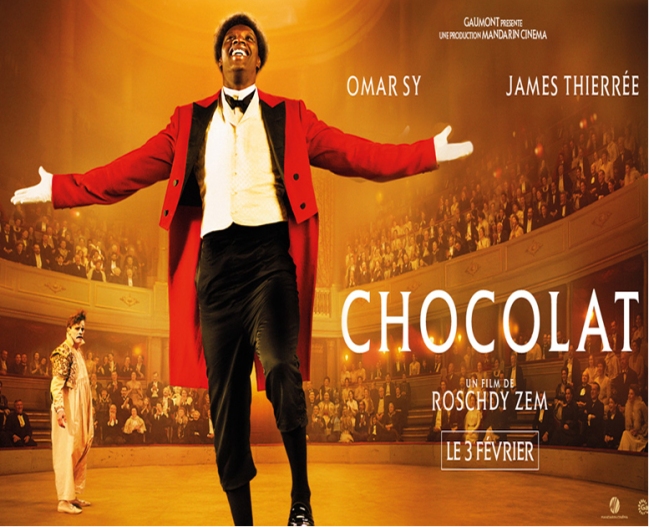 July
03
July
03
Tags
Chocolat (2016)

Films about racism come in a variety of genres and styles. Most are essays in conflict and hardship so it is unusual to find one that is based on circus clowns and laughter. The traditional circus was a mirror of the race and class structures of society and audience response reflected social values. This theme overarches the delightful French film Chocolat (2016) that is based on the true story of the first black-skinned circus entertainer in 19th century Paris.
A brief note on the history of clowns might help to see the deeper layers of this film. Dating to Greek and Roman theatre, the popularity of the clown’s low-class buffoonery reflects the human need to occasionally step outside of the norms of society. Their costumes and personality codes vary widely from the European harlequin jester or comical fool to the American down-and-out hobo caricature. Traditional circus clowns perform slapstick comedy in pairs: the white-faced clown is the instigator of gags, the red-faced (or Auguste) clown is the victim or fall-guy. With centuries of tradition behind them, it was a cultural shock for French circus audiences to see a black-faced Auguste clown for the first time and terrifying to know that it was not black makeup.
It is 1886 and the tired-looking Circus Delvaux is auditioning for acts to restore its fortunes. White clown George Foottit (James Thiérrée) is struggling to find work until he teams up with a former Cuban-negro slave with the stage name of Chocolat (Omar Sy). They quickly become a sensational duo, and the Delvaux circus prospers as crowds flock to see George kick, slap, and humiliate Chocolat. As their fame grows, Chocolat becomes the star celebrity and flaunts his success with flamboyant clothes, expensive car, gambling and substance abuse. Over time, Chocolat grows resentful of the racist taunts and abandons George for a career as a Shakespearean actor. Despite a credible performance as Othello, French audiences cannot accept a black person in serious theatre. With growing gambling debts and ill health, Chocolat ends his career in sadness and despair.
There are so many engaging layers in this film. Both co-stars are brilliant in their roles and the detailed period sets exude authenticity. The behind-the-tent circus life is full of unusual and interesting humanity living in convoys of small caravans that move entertainers from town to town. From the perspective of the modern screen-reliant world, it is charming to see the physicality and humour of the lost art of circus slapstick comedy. While today’s social conscience finds the blunt racism of a past era repulsive, this film reminds us of the ever-presence of race as a social divider. The appearance of black skin no longer shocks anyone but black talent is still the ‘Auguste’ in contemporary cinema.
This multi-layered film has a nuanced mix of humorous entertainment, historical insight and contemporary relevance. While funny faces, staring eyes, and goofy slapstick struggles to draw loud laughter today, the dark message of Chocolat lies in its portrait of racism masked as humour.

Director: Roschdy Zem
Stars: James Thiérrée, Omar Sy, Clotilde Hesme
Produced in France

Can’t wait to see this! A lovely review, as always.
I love Omar Sy.
LikeLiked by 1 person
Thanks Christine; its a great story told well.
LikeLike
Thanks for this review. I had heard the title but had no idea that this was a film about racism.
LikeLiked by 1 person
Your historical footnote adds great dimension to this review. I will look for Chocolat. But I’m always a bit surprised to find French disdain for black talent. It seems that by and large, the French have been far more accepting of their African citizens than other European countries. That fairy belief, I suppose, exposes my own lack of knowledge.
LikeLiked by 1 person
Thats a fair observation. In that respect, Chocolat may have been at the forefront of what has evolved to be a culture of acceptance. The shock of the new in the late 1800s is captured beautifully in one scene when a small boy wipes his finger across Chocolat’s face and is astonished to find his finger clean.
LikeLiked by 1 person
Your review are great! And this seems really different from what I have seen so far!
LikeLiked by 1 person
There are many diferent ways to review a film, and none are necessarily right or wrong. Thanks for your comment.
LikeLiked by 1 person
I share your opinion, and it was a pleasure to read your review!
LikeLiked by 1 person